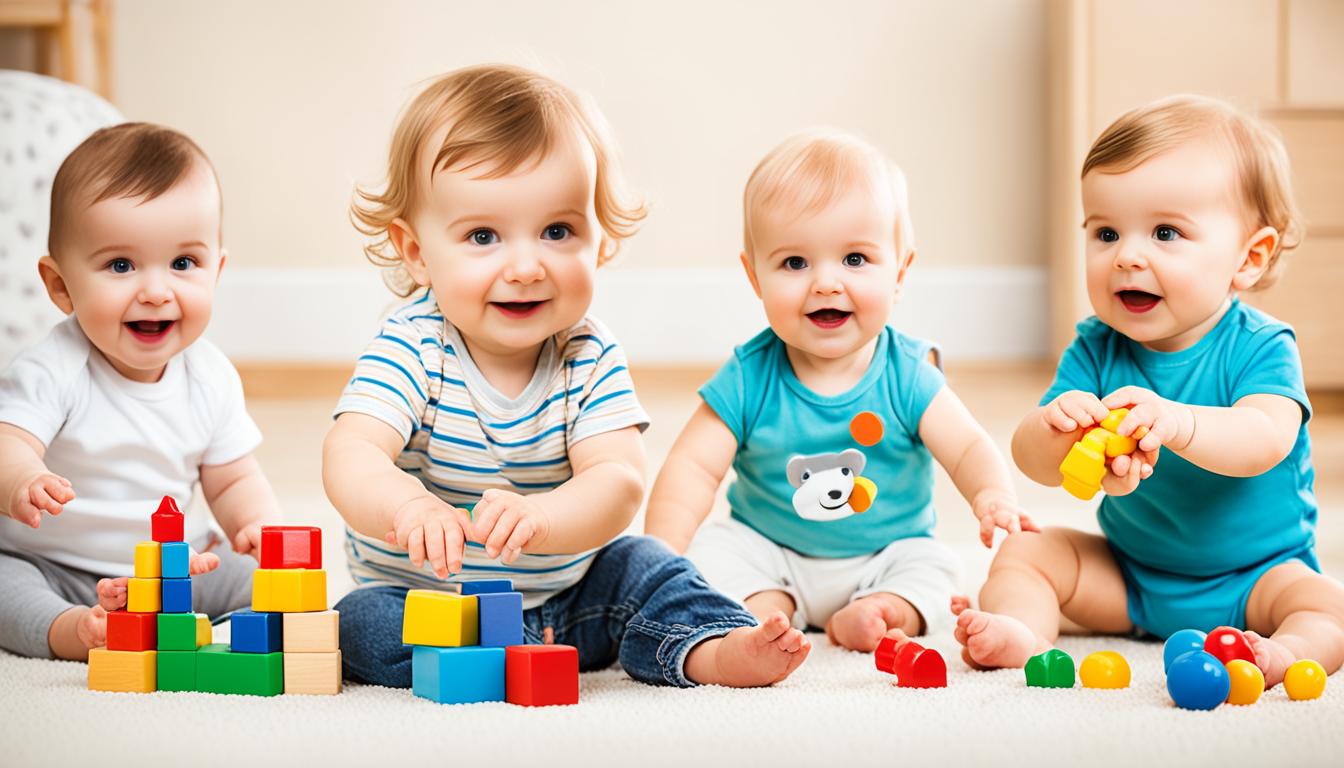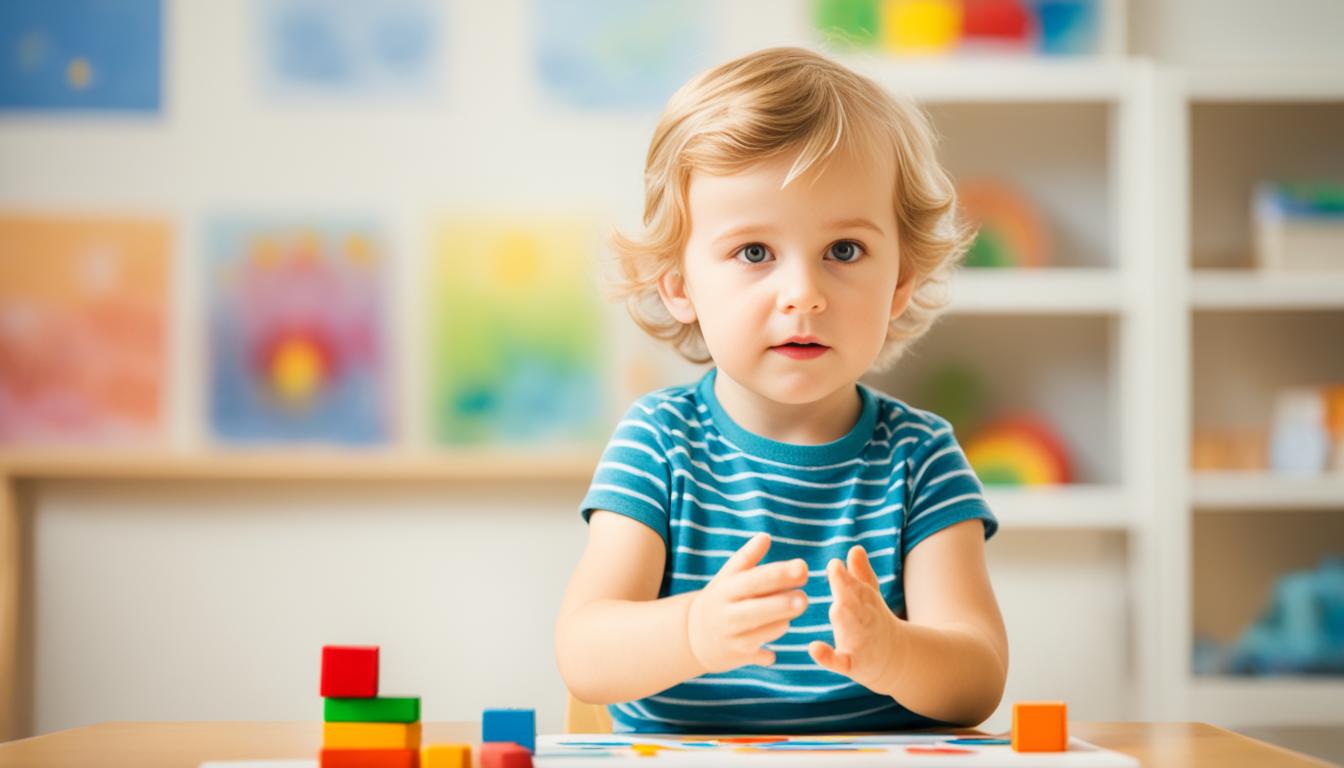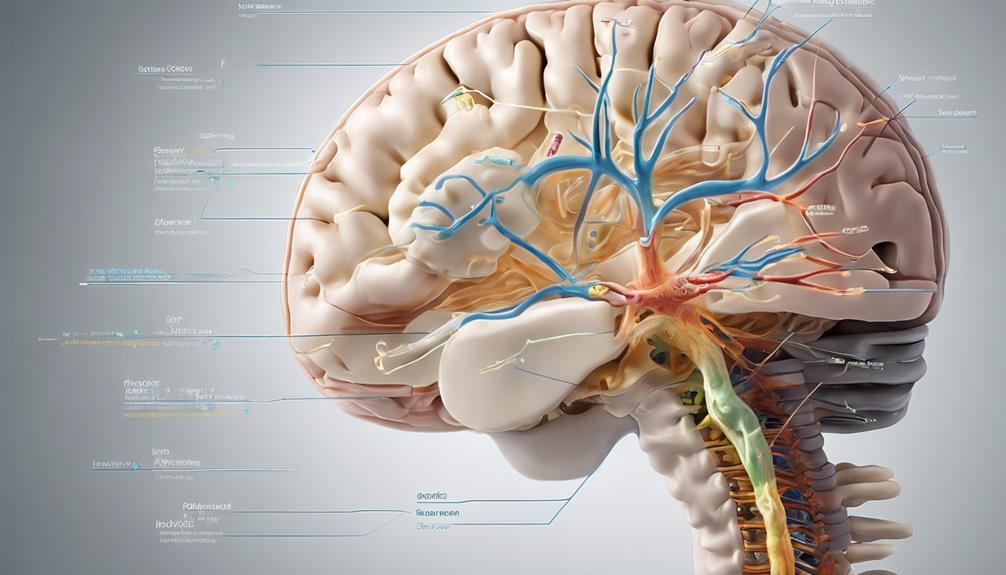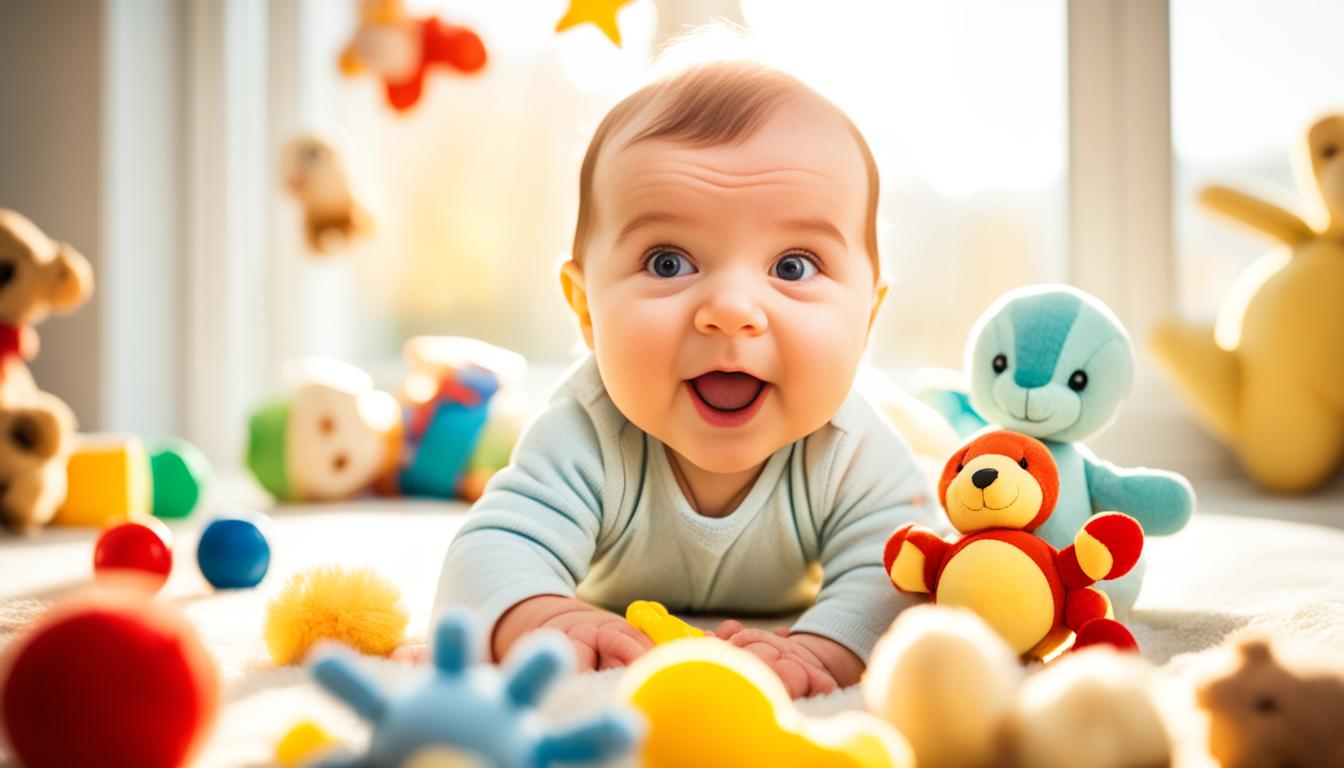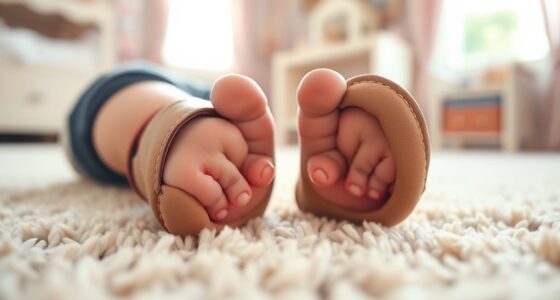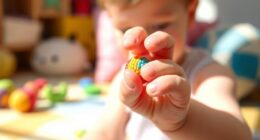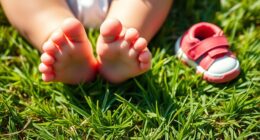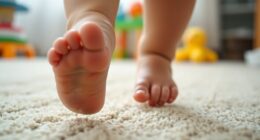As a parent, it is important to recognize and comprehend the various growth and developmental milestones that your child goes through in order to offer the appropriate support and direction. Each child goes through different stages, each bringing its own challenges and accomplishments. These developmental milestones provide insight into the transformations you can anticipate as your child matures. It is crucial to keep in mind that children develop at their own pace, but these milestones can be a useful tool in monitoring their advancements and detecting any potential concerns.
Children reach milestones in various aspects of their development. In terms of speech and language development, they begin to grasp the fundamentals of communication, from babbling their first words to formulating sentences that express their thoughts and needs. They also attain dressing skills, allowing them to become more independent in getting dressed and choosing their outfits.
Furthermore, children’s fine motor and visual motor skills improve over time. They gain the ability to perform intricate tasks such as holding a pencil, cutting with scissors, and drawing simple shapes. Additionally, they develop grooming skills like brushing their teeth, washing their hands, and taking care of their personal hygiene.
It’s important to note that growth and development are influenced by various factors, including genetics, gender, nutrition, physical activity, health problems, environment, and hormones1. These elements contribute to shaping a child’s growth trajectory and overall well-being. To assess a child’s growth, healthcare professionals utilize growth charts in conjunction with evaluating their overall health, genetic background, and environment1.
Girls and boys are measured on different growth charts due to the dissimilar growth patterns and rates between genders1. It’s also essential to consider specific growth charts for infants, children, and teens, as well as special charts for those with certain conditions or born prematurely1.
While growth charts are valuable tools, they do not provide a comprehensive view of a child’s development or overall health1. It’s crucial to consult with a pediatrician if you have any concerns or questions regarding your child’s growth or the interpretation of growth charts1.
Key Takeaways:
- Understanding your child’s growth and development milestones is essential for providing appropriate support.
- Children reach milestones in speech and language development, dressing skills, fine motor and visual motor skills, and grooming skills.
- Growth and development are influenced by genetics, gender, nutrition, physical activity, health problems, environment, and hormones.
- Growth charts, complemented by overall well-being and genetic background considerations, are used to assess a child’s growth.
- Consultation with a pediatrician is recommended for any concerns or questions about growth or interpreting growth charts.
Importance of Early Childhood Development Milestones
Developmental milestones offer important clues about a child’s developmental health. Reaching milestones at the typical ages shows that a child is developing as expected. Not reaching milestones or reaching them much later than other children of the same age may be a sign of a developmental delay.
According to the Rauch Foundation, 85 percent of a person’s brain is developed by the age of five, emphasizing the critical importance of the first five years in early childhood development2. Developmental milestones for physical growth and motor skills are reached during specific age ranges. For example, newborns demonstrate head control around the birth to 3 months stage, and most infants start to crawl between 6 to 9 months old2.
Cognitive milestones show progress in understanding and perception. Infants start recognizing familiar faces around the 3 to 6 months age range and develop object permanence by 9 to 12 months of age2. Additionally, cognitive development from 3 to 4 years includes children demonstrating curiosity and seeking answers to questions about how things work and why they happen2.
Physical milestones for children aged 1 to 5 years include activities like walking up and down stairs without assistance at 1 to 2 years and doing somersaults by 4 to 5 years2. These milestones indicate the progress of a child’s physical abilities and highlight the importance of promoting a healthy and active lifestyle.
Parents play a crucial role in encouraging both physical and cognitive development. By creating a supportive environment and providing opportunities for children to practice and explore their emerging skills, parents can contribute significantly to their child’s overall development2.
In summary, tracking developmental milestones is essential for monitoring a child’s development and determining if intervention or support is necessary. Reaching these milestones at the appropriate ages is indicative of healthy development, while delays may signal the need for further evaluation and assistance. Parents and caregivers can play an active role in promoting their child’s early childhood development by understanding and supporting their milestones.
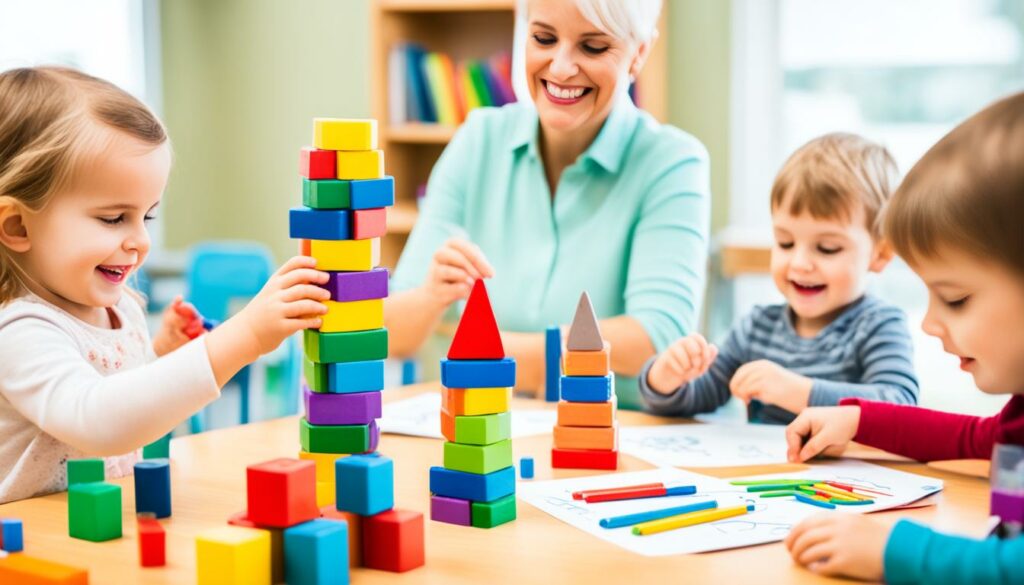
Cognitive Development in Early Childhood
Cognitive development in early childhood is a crucial stage in a child’s growth and learning journey. It encompasses the development of thinking, problem-solving, and information processing skills. During this period, children are actively exploring the world around them and building a foundation for future cognitive abilities.
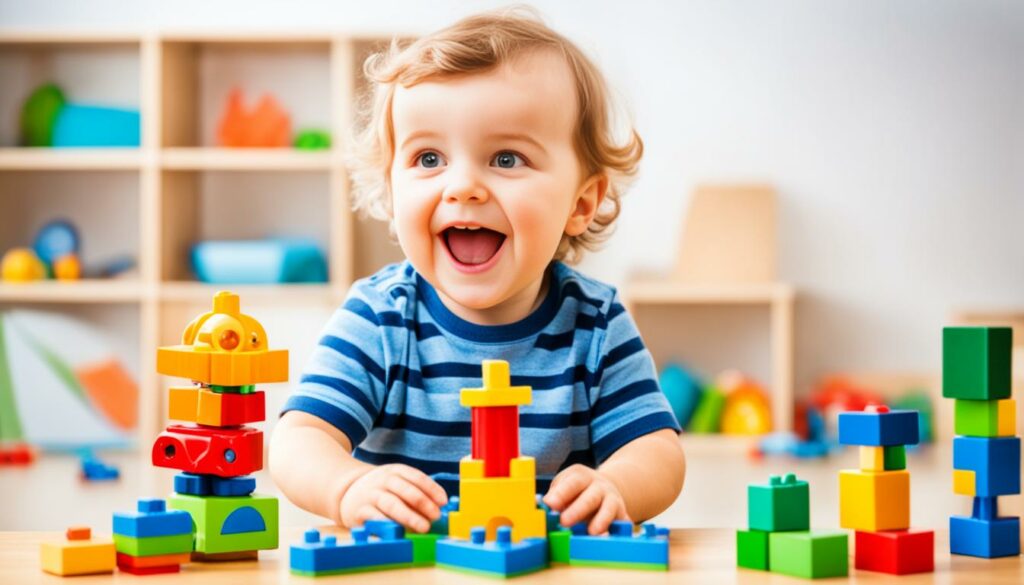
Charles Darwin’s groundbreaking work on childhood development, first published in 1877, laid the foundation for our understanding of cognitive development in children3. The pioneering research of Jean Piaget further divided child development into distinct stages: Sensorimotor, Pre-operational, Concrete Operational, and Formal Operational3. Piaget suggested that children typically master the “Theory of Mind” by 4 to 5 years of age3.
Children in their early years demonstrate various cognitive milestones. Around 36 months, children can understand simple time concepts, identify shapes, compare two items, and count to three3. At 48 months, they can count to four, identify four colors, and understand opposites3. By the age of five, children can count to ten accurately, recite the alphabet by rote, and recognize a few letters3.
Adolescents, aged 12 years and older, exhibit cognitive abilities such as logic and scientific problem-solving skills3. Early adolescence is a stage marked by questioning prevalent codes of conduct, which can lead to the development of personal ethics3.
Throughout history, children were initially perceived as miniature adults. It was only through rigorous psychological research that the unique nature of childhood thinking and cognitive development was recognized3. Babies are constantly learning, thinking, and exploring the world around them, actively absorbing and processing information3.
Parents play a vital role in fostering their child’s cognitive development. By encouraging exploration, curiosity, and intellectual growth, parents provide the necessary support and stimuli for their child’s cognitive abilities to flourish3. It is important to note that while developmental milestones serve as a guide, each child develops at their own pace, with some achieving milestones earlier or later than others3.
Social and Emotional Development in Early Childhood
Social and emotional development plays a crucial role in shaping a child’s overall well-being and future success in life. During early childhood, children undergo significant milestones that contribute to their ability to form relationships, regulate emotions, and empathize with others. It is an essential aspect of their growth that sets the foundation for healthy social interactions and emotional resilience4.
- Recognizing Familiar People: In the early years, children develop the ability to recognize and respond to familiar faces and voices, including their parents and caregivers4.
- Expressing Emotions Through Laughter: As they grow, children begin to express a wide range of emotions, often demonstrating joy and happiness through laughter5.
- Participating in Pretend Play: Pretend play becomes an important avenue through which children explore and understand social dynamics, taking on different roles and developing their imagination5.
- Forming Friendships: In early childhood, children start to form friendships and engage in cooperative play with their peers, allowing them to develop essential social skills such as sharing and taking turns5.
In addition to these milestones, social and emotional development encompasses various other factors such as recognizing and understanding the feelings of others, showing empathy, and developing self-awareness6. It is a dynamic process that continues to evolve throughout childhood and beyond, shaping how individuals navigate their relationships and emotions as they mature.
“Social and emotional development during early childhood is a critical foundation for healthy social interactions and emotional resilience.”
Parents, caregivers, and educators play pivotal roles in supporting children’s social and emotional development. Through positive role modeling, teaching empathy, and fostering a safe and nurturing environment, they can help children develop crucial skills that contribute to their overall emotional intelligence5.
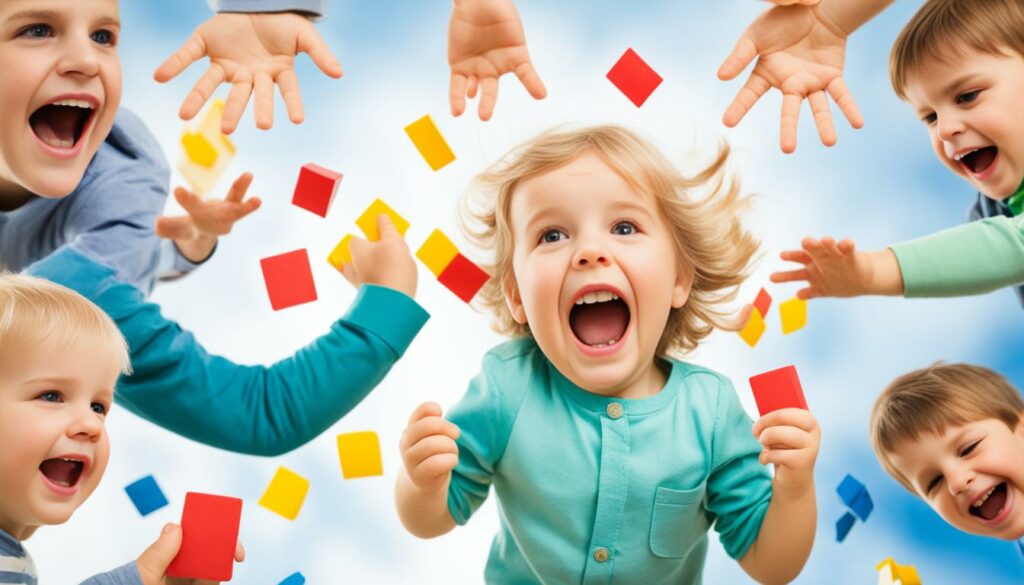
| Social and Emotional Development Milestones |
|---|
| Recognizing familiar people and voices |
| Expressing emotions through laughter |
| Participating in pretend play |
| Forming friendships |
Demonstrating empathy, understanding social cues, and effectively managing emotions are not only vital for establishing positive relationships but also contribute to a child’s overall academic and personal success. By fostering a supportive environment and providing the necessary guidance, parents and caregivers can help children thrive emotionally and socially6.
Social and emotional development in early childhood is a multifaceted process that deserves attention and nurturing. Through a combination of supportive relationships, intentional teaching, and exposure to diverse social experiences, children can develop the social and emotional competence necessary to navigate the intricacies of their social worlds5.
Physical Development in Early Childhood
Physical development in early childhood is a crucial aspect of a child’s overall growth and well-being. During this stage, children experience significant milestones in their motor skills and coordination, laying the foundation for their future physical abilities.
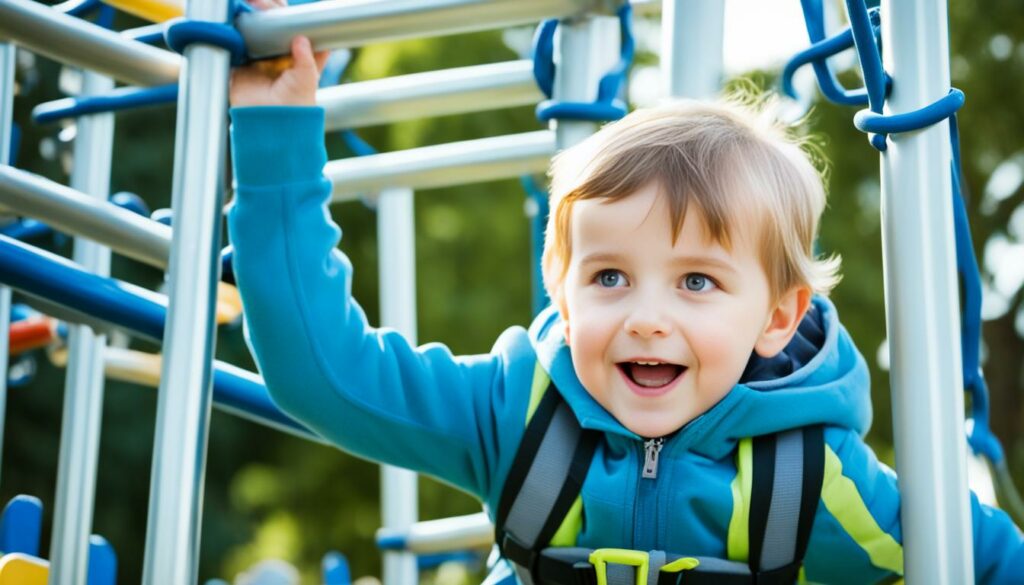
Milestones in physical development encompass both fine motor skills, which involve precise use of the muscles in the hands and fingers, and gross motor skills, which involve larger muscle groups and enable whole-body movements like running and jumping.
Developing fine motor skills is essential for various tasks requiring detailed hand-eye coordination, such as stacking small blocks or manipulating buttons and zippers7. These activities help children refine their dexterity and control over their hands, promoting their ability to perform more intricate tasks as they grow.
On the other hand, gross motor skills allow children to engage in active play and navigate the physical world around them. Toddlers, for example, demonstrate their physical abilities by walking on their own, climbing furniture, and feeding themselves with utensils7. These milestones mark significant progress in their physical development and self-sufficiency.
It is important to note that each child’s physical development is influenced by a unique combination of genetics, prenatal factors, and environmental conditions. Individual differences should be taken into account when supporting physical development in early childhood. Creating nurturing environments that encourage exploration, play, and physical activity helps optimize children’s growth and development7.
Providing varied play activities is crucial in fostering physical development in children. Engaging in activities such as running, climbing, jumping, and playing with age-appropriate toys not only enhances their motor skills but also promotes overall physical fitness, coordination, and balance.
Regular developmental check-ups with healthcare professionals play a vital role in monitoring a child’s physical growth and identifying any potential concerns or delays. Additionally, ensuring access to nutritious food supports optimal physical growth and provides essential nutrients that aid in the development of healthy muscles and bones7.
Summary:
In early childhood, physical development encompasses both fine and gross motor skills, which are crucial for a child’s ability to perform specific tasks and engage in whole-body movements. Supporting physical development involves understanding individual differences, creating nurturing environments, providing varied play activities, and ensuring regular developmental check-ups and access to nutritious food.
Language Development Milestones
In early childhood, language development milestones play a vital role in a child’s overall communication skills and cognitive development. These milestones mark the progression of a child’s ability to understand and use language to express themselves and engage with others. Let’s explore some key language development milestones that children typically reach during their early years.
Babbling and First Words
At around8 six months of age, most babies begin to recognize the basic sounds of their native language. They start experimenting with babbling, producing a variety of sounds that lay the foundation for speech development. By the age of one, children usually say their first words, such as “mama” or “dada,” which mark a significant milestone in their language acquisition journey.
Combining Words and Simple Sentences
As children progress through their second year, they start combining words to form simple sentences. By9 two years old, a child may have a vocabulary of about 250-300 words. They can communicate basic needs and express simple thoughts using two-word phrases such as “more milk” or “big dog.”
Understanding Complex Instructions
As their language skills continue to develop, children become increasingly adept at understanding complex instructions. By the age of three years, children are expected to use around 1000 words and comprehend more intricate sentences. They can follow two-step directions and engage in conversations that involve multiple turns.
Expanding Vocabulary and Sentence Structure
Between three and four years old, children expand their vocabulary significantly. They begin using nearly 1500 words and demonstrate more sophisticated sentence structure. Five-word and six-word sentences become common as children develop a better understanding of grammar and syntax.
Increased Comprehension and Language Skills
By the five to six years range, vocabulary comprehension increases even further. Children can understand and use more complex words and phrases, allowing them to express themselves more precisely. They also develop the ability to classify objects according to specific traits such as form, color, use, or composition.
Effective Communication and Listening Skills
By the age of six to seven years, children should be capable of attending to a guest speaker or teacher for a sustained period of time. Their communication and listening skills continue to improve, enabling them to engage in more advanced conversations and comprehend more abstract ideas.
Throughout these language development milestones, it’s important to remember that children may vary in their speech and language skills. However, they generally follow a natural progression and timing for mastering these skills. It’s vital to provide a supportive and enriching environment that encourages language development.
Researchers sponsored by the National Institute on Deafness and Other Communication Disorders (NIDCD) conduct ongoing studies to understand the development of speech and language disorders and explore more effective treatments and diagnostic capabilities8. Additionally, ongoing research focused on children with autism spectrum disorders who do not develop functional verbal language by the age of five aims to address research gaps and develop better treatment strategies8.
Language development milestones in early childhood are crucial in shaping a child’s ability to interact with the world and express themselves. By understanding these milestones and providing support and appropriate intervention when needed, parents and caregivers play an essential role in fostering a child’s language development journey.
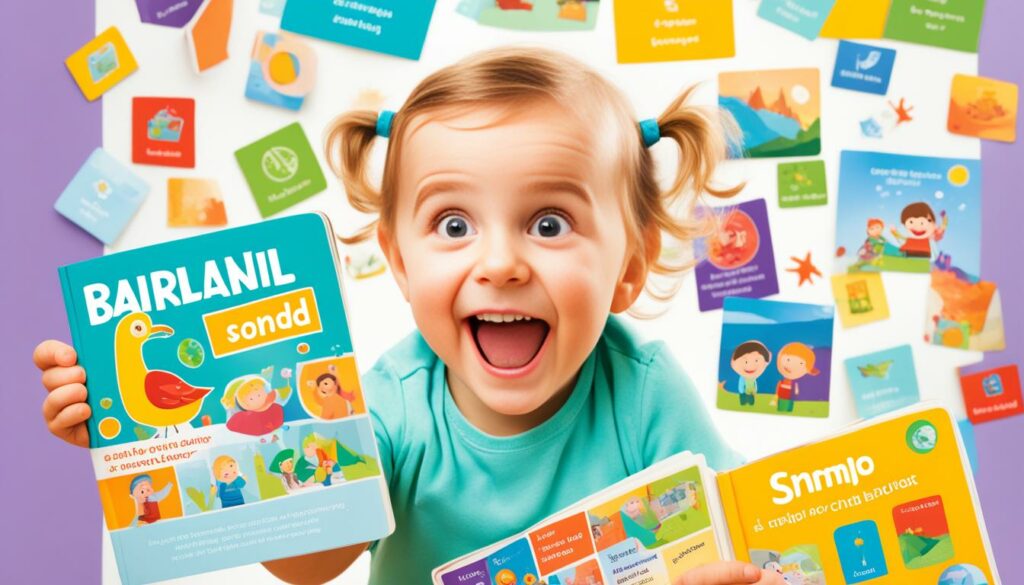
Stages of Brain Development in Children
Brain development in children occurs in stages, each playing a vital role in shaping their cognitive, emotional, and physical abilities. As a child develops, their brain goes through several significant milestones that contribute to their overall growth and development.
During early brain development in infancy, the brain undergoes rapid growth and forms the foundation for future cognitive and behavioral abilities. It is during this stage that the brain reaches nearly full grown capacity by age 510.
Within the first year after birth, an average baby’s brain doubles in size, highlighting the remarkable growth and development that takes place during this early stage10.
The early childhood years are characterized by an astonishing rate of neural connections being formed. At least one million new neural connections are created every second during this period, surpassing any other point in life10.
These early years provide the optimal opportunity for developing connections that are essential for higher-level abilities, including motivation, self-regulation, problem-solving, and communication10. It is through everyday experiences that young children develop these brain connections, significantly influenced by positive interactions with parents and caregivers10.
Furthermore, research has shown that children who experience positive interactions in their early years tend to be healthier and more successful in school and in life10. On the other hand, adverse experiences such as poverty and exposure to violence can negatively impact a child’s early brain development and long-term success10.
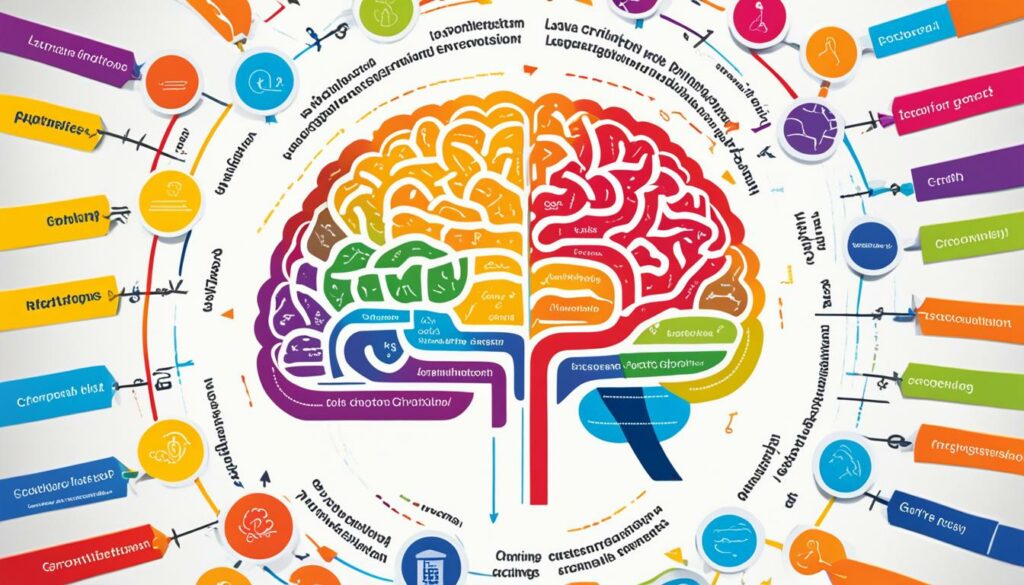
Understanding the Key Stages of Brain Development
To comprehend a child’s cognitive and behavioral development, it is crucial to understand the key stages of brain development. These stages span from early brain development in infancy to ongoing development throughout childhood and adolescence, contributing to the formation of vital neurological connections10.
| Stage | Developmental Highlights |
|---|---|
| Early Brain Development in Infancy | Rapid growth and reaching nearly full capacity by age 510 |
| Rapid Growth and Synaptic Pruning in Early Childhood | Brain doubles in size within the first year after birth10. At least one million new neural connections formed every second10 |
| Ongoing Development throughout Childhood and Adolescence | Continued growth, refinement, and specialization of brain regions10 |
Understanding these stages of brain development helps parents, caregivers, and educators support children’s cognitive and behavioral growth effectively. By providing enriching experiences and nurturing positive interactions, we can foster healthy brain development during these critical stages.
Early Childhood Education and Development
Early childhood education is a crucial component in the holistic development of a child. Research has shown that high-quality early education programs play a significant role in supporting and enhancing a child’s cognitive, social, emotional, and physical development11. These programs provide children with structured and nurturing environments where they can learn and develop essential skills that form the foundation for their future academic and personal success.
One of the primary goals of early childhood education is to promote cognitive development. Children in these programs engage in age-appropriate activities that stimulate their thinking and problem-solving abilities. They learn to explore, ask questions, and develop critical thinking skills11. By fostering a love for learning at an early age, children are equipped with the tools they need to succeed academically and thrive in a constantly evolving world.
Early childhood education also plays a vital role in supporting social and emotional development. Through interactions with peers and educators, children develop essential social skills such as sharing, taking turns, and collaborating11. They learn to navigate relationships, resolve conflicts, and develop empathy and understanding towards others. These skills are crucial for building healthy relationships and for effectively communicating and interacting with others throughout their lives.
Furthermore, early education programs provide opportunities for physical development. Children engage in various physical activities, such as outdoor play, that promote the development of motor skills, coordination, and physical fitness11. Engaging in these activities not only supports physical development but also instills a lifelong appreciation for an active and healthy lifestyle.
It is important to note that early childhood education goes beyond academic learning. These programs also foster the development of essential life skills such as problem-solving, resilience, and self-regulation11. By providing a supportive and stimulating environment, educators help children develop the confidence and skills they need to navigate challenges and succeed in various aspects of life.
Parents and caregivers play an integral role in their child’s early education and development. They are encouraged to actively participate in their child’s learning journey, through parent-teacher collaborations and engagement in activities that support their child’s development11. By working together, parents, caregivers, and educators can ensure that each child receives the individualized support and guidance they need to reach their full potential.
Early childhood education programs, along with the collaboration between parents, caregivers, and educators, create a strong foundation for a child’s lifelong learning and development. By investing in quality early education, we empower children to become confident, well-rounded individuals who are prepared for the challenges and opportunities that lie ahead.
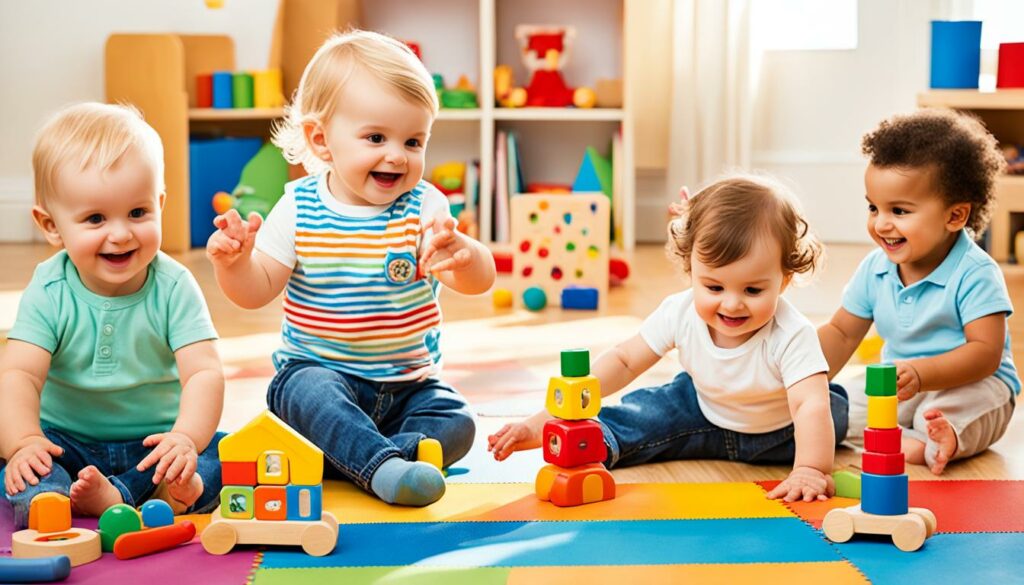
References:
- Statistical Data: Link 1
Stages of Psychosocial Development in Early Childhood
In early childhood, children go through a series of stages that contribute to their psychosocial development, shaping their emotional, social, and identity-related skills. Erik Erikson’s theory presents a framework consisting of eight stages that individuals experience from infancy to late adulthood. These stages offer insights into the challenges and milestones children encounter, building a foundation for their future development12.
The first stage of psychosocial development is Trust vs. Mistrust, which occurs from birth to approximately 18 months. During this stage, infants learn to trust caregivers and their environment. Successful trust-building can lead to the virtue of hope, fostering a sense of security and optimism. Conversely, if trust is not established, fear and mistrust may emerge, impacting future relationships12.
The second stage, Autonomy vs. Shame and Doubt, takes place from 18 months to around 3 years. At this stage, children develop a sense of personal control and independence. Successfully building autonomy can lead to the virtue of will, promoting confidence and self-assurance. Encouraging independence during the earlier stages, such as Trust vs. Mistrust, can help foster resilience and coping skills in children12.
The third stage, Initiative vs. Guilt, occurs during the preschool years (3 to 5 years). During this stage, children assert their power and control over their world through play and social interactions. Encouraging initiative can help children develop planning skills and a sense of purpose. However, discouragement may lead to guilt and hesitation in taking independent actions12.
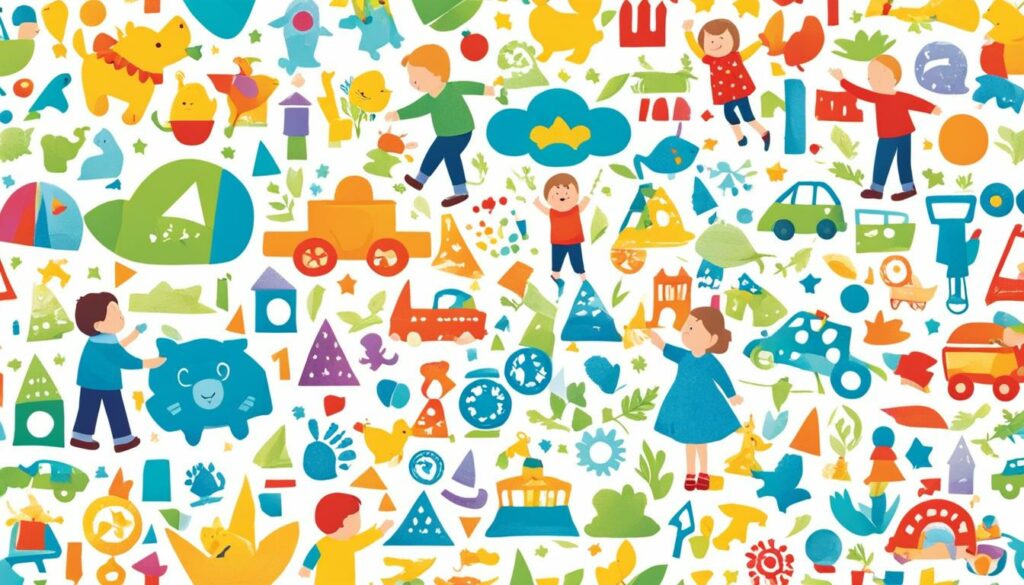
Building a strong foundation in the early stages of psychosocial development is essential as it influences a child’s emotional well-being, social interactions, and self-identity. It is a lifelong process, with each stage presenting unique challenges and opportunities for growth. Bowlby and Ainsworth’s research highlight the significance of early attachment experiences on future relationships, emphasizing the importance of nurturing emotional connections during these formative years12.
| Stage | Age Range |
|---|---|
| 1. Trust vs. Mistrust | Birth to 18 months |
| 2. Autonomy vs. Shame and Doubt | 18 months to 3 years |
| 3. Initiative vs. Guilt | 3 to 5 years |
These stages of psychosocial development in early childhood serve as a roadmap for understanding a child’s emotional and social growth. By recognizing the unique challenges and milestones of each stage, parents, caregivers, and educators can provide the necessary support to foster healthy development in children12.
Monitoring Early Childhood Development Milestones
Monitoring early childhood development milestones is crucial for parents and caregivers to ensure their child’s growth and development is on track. By tracking a child’s milestones, you can gain valuable insights into their progress and identify any potential developmental delays or concerns. This proactive approach allows for early intervention and support, helping children reach their full potential.
Healthcare professionals, such as pediatricians and child development specialists, play a vital role in monitoring and assessing a child’s growth and development. They provide guidance on milestones and offer strategies for supporting a child’s overall growth in various areas. Regular check-ups with these professionals allow for ongoing monitoring of developmental milestones and early detection of any developmental issues, ensuring timely support and intervention13.
Developmental milestones for infants encompass various aspects of their growth and development. These include weight gain, environmental curiosity, physical awareness, speech development, emotional expression, and the ability to differentiate between familiar and unfamiliar individuals13. By observing and tracking these milestones, parents and caregivers can gauge the progress of their child’s early development and ensure they are meeting age-appropriate goals.
Toddlers and preschoolers go through rapid development in multiple areas. They show significant language development, social interest and interaction, cognitive advancement, improvement in motor skills, and engage in imaginative play13. Tracking these milestones provides insight into a child’s growth and ability to communicate, interact, and navigate their world.
As children move into elementary school, they continue to demonstrate growth and development. They exhibit enhanced reading and writing skills, increased social interactions, moral development, improved emotional control, and experience growth spurts13. These milestones reflect their expanding knowledge and abilities, further shaping their overall development.
During adolescence, children undergo significant physical, hormonal, and emotional changes. They seek stronger social relationships, demonstrate complex understanding, strive for independence, and experience individualized growth patterns13. Monitoring these milestones enables parents and caregivers to provide necessary support and guidance during this crucial transitional period.
Emotional development in children evolves over time, progressing from reacting to stimuli to expressing emotions through verbal communication. The aim is to develop emotional regulation and self-control13. Parents and caregivers can observe and track these milestones to ensure a child’s emotional well-being and provide appropriate support as needed.
Social development is a critical aspect of early childhood development. Children progress from forming attachments to familiar individuals to engaging with peers, sharing, cooperation, and ultimately forming friendships13. Monitoring these milestones allows parents and caregivers to encourage healthy social interactions and foster positive relationships.
Language development is a key component of early childhood development. Parents are encouraged to track their child’s language development from babbling to forming full sentences. This includes observing their cognitive growth, from sensory-motor learning to abstract thinking13. Monitoring language milestones helps identify any potential language delays and ensures appropriate support and intervention.
Physical development, including growth in height and weight, motor skill refinement, and the influence of nutrition, sleep, and exercise, is essential for a child’s overall development13. Monitoring these milestones helps assess a child’s physical well-being and provides guidance on promoting a healthy and active lifestyle.
Integrated care practices, involving the collaboration of healthcare professionals and educators, help monitor and address cognitive abilities that may fall outside the normal range for a child’s age. This ensures access to appropriate care for growth and development13. By taking a holistic approach to monitoring a child’s development, professionals can provide targeted interventions and support to optimize a child’s abilities.

Developmental Monitoring and Screening Tools
Developmental monitoring and screening tools play a significant role in tracking a child’s milestones and identifying potential developmental concerns. These tools help parents, grandparents, early childhood providers, and other caregivers observe how a child grows and changes over time, ensuring they are meeting typical developmental milestones in various areas14.
Some commonly used tools for developmental monitoring and screening include:
- Ages and Stages Questionnaire (ASQ-3): This assessment tool is designed to assess five domains for children aged 2 to 60 months14. It helps identify any delays or concerns in communication, gross motor skills, fine motor skills, problem-solving, and personal-social skills.
- Parents Evaluation of Developmental Status (PEDS): Available in multiple languages including English, Spanish, and Vietnamese, this tool allows parents and caregivers to assess a child’s developmental progress and raise any concerns14.
- Bayley Infant Neurodevelopmental Screen (BINS): Designed for infants aged 3 to 6 months, this assessment tool helps identify neurologically impaired infants and developmental delays14. It provides valuable insights into a child’s early neurodevelopmental health.
Regular developmental screenings are recommended during well-child visits, ensuring comprehensive monitoring of a child’s growth and development15. These screenings are conducted even when there are no existing concerns, allowing for early detection of any potential developmental issues and prompt intervention when needed.
By actively monitoring a child’s early childhood development milestones and utilizing appropriate screening tools, parents and caregivers can support their child’s growth and development more effectively. Early detection and intervention contribute to better outcomes and a child’s overall well-being and success.
Conclusion
Understanding early childhood development stages is vital for parents and caregivers to support a child’s growth and potential. By recognizing and monitoring milestones in areas such as cognitive, social, emotional, and physical development, you can provide the necessary support and interventions to ensure your child’s overall development and well-being.
Investing in early intervention and support has been shown to have a lasting positive impact on a child’s life16. For example, children typically start walking between 9 and 15 months of age, marking a significant physical milestone in their development16. Early childhood is a crucial period for shaping a child’s brain architecture and cognitive abilities, as the brain is highly plastic during these formative years16. Cognitive abilities rapidly develop in preschoolers, expanding their problem-solving skills and imaginative thinking16.
Preschoolers also experience social and emotional milestones, such as developing greater independence and engaging in cooperative play with their peers16. Additionally, language acquisition begins in infancy, with babies starting to make sounds, imitate expressions, and understand simple words16. Fine motor skills continue to develop in preschoolers, enabling them to handle smaller objects precisely and improve their writing abilities16.
Parents play a significant role in a child’s development and socialization, and child-care programs can benefit childhood development in learning and social skills17. By providing children with enriching experiences and opportunities for learning, you can help strengthen their neural connections and enhance their cognitive abilities16. Overall, understanding and supporting your child’s development milestones are crucial for their growth and future success.
FAQ
What are early childhood development stages?
Why are child development milestones important?
What is cognitive development in early childhood?
What is social and emotional development in early childhood?
What is physical development in early childhood?
What are language development milestones?
What are the stages of brain development in children?
How does early childhood education support development?
What are the stages of psychosocial development in early childhood?
Why is monitoring early childhood development milestones important?
Source Links
- https://www.choc.org/primary-care/ages-stages/
- https://www.all4kids.org/news/blog/why-the-first-5-years-of-child-development-are-so-important/
- https://www.ncbi.nlm.nih.gov/books/NBK537095/
- https://www.ncbi.nlm.nih.gov/books/NBK534819/
- https://www.verywellmind.com/social-and-emotional-development-in-early-childhood-2795106
- https://www.rasmussen.edu/degrees/education/blog/stages-of-emotional-development/
- https://qualitystartsbc.org/physical-development-supporting-children-ages-zero-to-three/
- https://www.nidcd.nih.gov/health/speech-and-language
- https://childdevelopment.com.au/resources/child-development-charts/stages-of-language-development-chart/
- https://www.firstthingsfirst.org/early-childhood-matters/brain-development/
- https://www.npcmc.com/2022/07/08/the-5-stages-of-early-childhood-development/
- https://www.simplypsychology.org/erik-erikson.html
- https://lchcommunityhealth.org/understanding-child-development-milestones-stages-and-growth/
- https://cmcfresno.com/blog/the-importance-of-early-childhood-developmental-monitoring-and-screening/
- https://www.cdc.gov/ncbddd/actearly/screening.html
- https://www.graygroupintl.com/blog/early-childhood-development-stages
- https://en.wikipedia.org/wiki/Child_development

